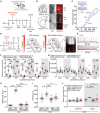Anterior cingulate cortex and its projections to the ventral tegmental area regulate opioid withdrawal, the formation of opioid context associations and context-induced drug seeking
- PMID: 35992922
- PMCID: PMC9388764
- DOI: 10.3389/fnins.2022.972658
Anterior cingulate cortex and its projections to the ventral tegmental area regulate opioid withdrawal, the formation of opioid context associations and context-induced drug seeking
Abstract
Clinical evidence suggests that there are correlations between activity within the anterior cingulate cortex (ACC) following re-exposure to drug-associated contexts and drug craving. However, there are limited data contributing to our understanding of ACC function at the cellular level during re-exposure to drug-context associations as well as whether the ACC is directly related to context-induced drug seeking. Here, we addressed this issue by employing our novel behavioral procedure capable of measuring the formation of drug-context associations as well as context-induced drug-seeking behavior in male mice (8-12 weeks of age) that orally self-administered oxycodone. We found that mice escalated oxycodone intake during the long-access training sessions and that conditioning with oxycodone was sufficient to evoke conditioned place preference (CPP) and drug-seeking behaviors. Additionally, we found that thick-tufted, but not thin-tufted pyramidal neurons (PyNs) in the ACC as well as ventral tegmental area (VTA)-projecting ACC neurons had increased intrinsic membrane excitability in mice that self-administered oxycodone compared to controls. Moreover, we found that global inhibition of the ACC or inhibition of VTA-projecting ACC neurons was sufficient to significantly reduce oxycodone-induced CPP, drug seeking, and spontaneous opioid withdrawal. These results demonstrate a direct role of ACC activity in mediating context-induced opioid seeking among other behaviors, including withdrawal, that are associated with the DSM-V criteria of opioid use disorder.
Keywords: CPP; anterior cingulate cortex; oxycodone; self-administration; ventral tegmental area.
Copyright © 2022 McKendrick, McDevitt, Shafeek, Cottrill and Graziane.
Conflict of interest statement
The authors declare that the research was conducted in the absence of any commercial or financial relationships that could be construed as a potential conflict of interest.
Figures




Similar articles
-
Anterior cingulate cortex is necessary for spontaneous opioid withdrawal and withdrawal-induced hyperalgesia in male mice.Neuropsychopharmacology. 2021 Oct;46(11):1990-1999. doi: 10.1038/s41386-021-01118-y. Epub 2021 Aug 2. Neuropsychopharmacology. 2021. PMID: 34341495 Free PMC article.
-
The projections from the anterior cingulate cortex to the nucleus accumbens and ventral tegmental area contribute to neuropathic pain-evoked aversion in rats.Neurobiol Dis. 2020 Jul;140:104862. doi: 10.1016/j.nbd.2020.104862. Epub 2020 Apr 3. Neurobiol Dis. 2020. PMID: 32251841
-
The Role of Mu Opioid Receptors in High Fat Diet-Induced Reward and Potentiation of the Rewarding Effect of Oxycodone.Life (Basel). 2023 Feb 23;13(3):619. doi: 10.3390/life13030619. Life (Basel). 2023. PMID: 36983775 Free PMC article.
-
Implication of dopaminergic projection from the ventral tegmental area to the anterior cingulate cortex in μ-opioid-induced place preference.Addict Biol. 2010 Oct;15(4):434-47. doi: 10.1111/j.1369-1600.2010.00249.x. Epub 2010 Aug 23. Addict Biol. 2010. PMID: 20731628
-
Localization of brain reinforcement mechanisms: intracranial self-administration and intracranial place-conditioning studies.Behav Brain Res. 1999 Jun;101(2):129-52. doi: 10.1016/s0166-4328(99)00022-4. Behav Brain Res. 1999. PMID: 10372570 Review.
Cited by
-
Oral fentanyl consumption and withdrawal impairs fear extinction learning and enhances basolateral amygdala principal neuron excitatory-inhibitory balance in male and female mice.Addict Neurosci. 2024 Dec;13:100182. doi: 10.1016/j.addicn.2024.100182. Epub 2024 Oct 15. Addict Neurosci. 2024. PMID: 39742087 Free PMC article.
-
Deep brain stimulation of the anterior cingulate cortex reduces opioid addiction in preclinical studies.Sci Rep. 2025 Jan 15;15(1):2065. doi: 10.1038/s41598-025-86279-2. Sci Rep. 2025. PMID: 39815019 Free PMC article.
-
Distinct role of claustrum and anterior cingulate cortex bidirectional circuits in methamphetamine taking and seeking.Nat Commun. 2025 Jul 25;16(1):6871. doi: 10.1038/s41467-025-62188-w. Nat Commun. 2025. PMID: 40715089 Free PMC article.
-
Comparing withdrawal- and anxiety-like behaviors following oral and subcutaneous oxycodone administration in C57BL/6 mice.Behav Pharmacol. 2024 Aug 1;35(5):269-279. doi: 10.1097/FBP.0000000000000780. Epub 2024 Jun 3. Behav Pharmacol. 2024. PMID: 38847447 Free PMC article.
-
Voluntary alcohol intake alters the motivation to seek intravenous oxycodone and neuronal activation during the reinstatement of oxycodone and sucrose seeking.Sci Rep. 2023 Nov 6;13(1):19174. doi: 10.1038/s41598-023-46111-1. Sci Rep. 2023. PMID: 37932476 Free PMC article.
References
-
- Administration S. (2014). Gender Differences in Primary Substance of Abuse across Age Groups. Available online at: https://www.samhsa.gov/data/sites/default/files/sr077-gender-differences... (accessed December 6, 2022). - PubMed
-
- Administration U. S. (2017). FDA Grants Marketing Authorization of the First Device For Use in Helping to Reduce the Symptoms of Opioid Withdrawa. Available online at: https://www.fda.gov/news-events/press-announcements/fda-grants-marketing... (accessed December 6, 2022).
LinkOut - more resources
Full Text Sources
Research Materials

